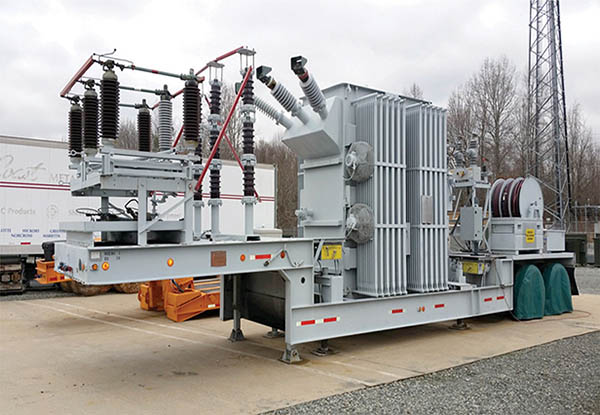
[panel panel-style="panel" color="primary" title="Fast%20Facts%3A%20NCEMC%20Mobile%20Substations"]
- First established in 1985
- Eight mobile units staged throughout N.C.
- Rating: 5 MVA to 30 MVA
Benefits to Members
- Backup transformers
- Two units available per member
- Technical support
- Substation testing services
- Maintenance
- Component testing
- Troubleshooting
[/panel]
Mobile substations are invaluable on certain maintenance and repair jobs, but they’re expensive.
“They can run anywhere from $1.5 million on up,” says Carlton Lewis, technical field services manager at North Carolina Electric Membership Corp.
So the Raleigh-based G&T worked with 16 member cooperatives on a solution: a mobile substation pool.
The pool comprises eight units—three owned by co-op members, five owned by NCEMC—with ratings from 5 to 30 MVA and voltages from 13.2 to 120 kV.
Sharing the cost of ownership and upkeep lets more co-ops access their capabilities, says Lewis, the pool supervisor.
“It makes it affordable for the smaller co-ops that don’t have the finances to purchase these things,” he says.
Substations are transported on flatbed trailers and are positioned around the state. Dues are based on the share of total mobile capacity that each co-op represents.
Patti Metro, NRECA senior grid operations and reliability director, says such pools are “an important reliability tool” for co-ops.
The North Carolina co-ops use their pool mainly for maintenance, Lewis says. But they’re also deployed for substation expansion or construction as well as for emergencies.
Piedmont Electric Membership Corp. in Hillsborough, North Carolina, has tapped pool transformers for routine and unexpected issues.
“We’re a radial-fed system, so we don’t have many back-feed opportunities,” says Vice President of Engineering Larry Hopkins. “It gives us a backup so we can take down our transformers and perform maintenance and testing … and still feed [power to] our members.
“It’s also our insurance policy in the event of catastrophic failure.”
Membership in the pool also comes with a testing service.
“Just about any test for our high-side equipment we can do by using our mobiles, and the NCEMC personnel do all of our scheduled transformer testing,” Hopkins says. “We couldn’t be more pleased with the way it’s worked out for us.”
